The tapestry class I’m teaching started earlier this week, and since we are studying traditional Gobelins style techniques, I can’t get the “Lady and the Unicorn” off my mind. I started reading the book I bought at the museum, which also brings up bits of info that are filed deeply in my brain from my college years–a long, long time ago at this point. I enjoyed studying the MIddle Ages in college, in between the classes I needed for my majors.
During the Middle Ages a popular literary form was the bestiary, in which stories about real and imaginary animals were told in order to convey moral concepts. The unicorn featured often in these tales, where it represented two opposing sides of the same idea: ideas of purity, virginity, and Christian virtues, as well as less pure concepts of sexual desire and attractions, giving into one’s senses. At this time in history the senses were considered to be base, in need of control by the higher call of duty and control of one’s desires. There are descriptions of a 6th sense, the heart or the soul, an inner compass that could give guidance to the lower senses of touch, taste, sight, smell and hearing. So, naturally, many scholars have weighed in on what that might mean to the purpose of the story in the six tapestries of the ‘Lady and the Unicorn.’ After 500 years, there are still so many disagreements–and unknowns.
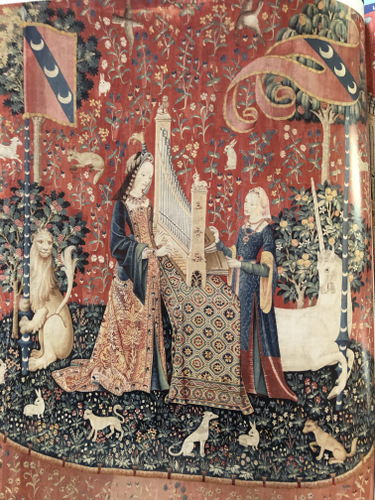
I was intrigued to learn that the tapestries were repaired in the late 19th c., after being acquired by the Cluny Museum, and that the woven areas near the bottom of certain pieces have faded dramatically from the rich red to a greyish pink. The upper areas that are still original have surely faded some, but are still a deep madder red. What was used on the repaired areas? Could it have been the recently developed aniline dyes? Can I get an answer on this? Do you see the badly faded area at the bottom of “Hearing?”
I find the photos is in the book I bought so inspiring! The facial expressions on the woman and her lady in waiting, their wonderful hairstyles, their jewelry, their clothing!–I can look and look and still find more that amazes me. The animals and flowers are endlessly entertaining, aren’t they? A few years ago, when I still lived near the Cloisters, I took a tour with a docent who focused on the gardens there and what the plants were used for edibly and medicinally, and in folkore . She told us stories about what strengths various plants were believed to lend to the body if eaten, or applied in some way. At the end of the tour, the docent took us to the gallery with the “Hunt for the Unicorn” to show us many of the same plants depicted in the millefleur: foxglove, carnations, roses, lilies, and plenty of others. How amazing that these plants were so well portrayed 500 years ago. Just writing about this memory makes me want to weave!
At the moment it’s the organ and the woven rug in “Hearing” that make me think this is the best tapestry I’ve ever seen. How many weavers sat side by side to work on this? Did more than one weaver work on the organ pipes which are spot-on brilliant? That rug is a show stopper too, not to mention the Lady and her maid. Whatever these weavers made in wages, it was not enough!
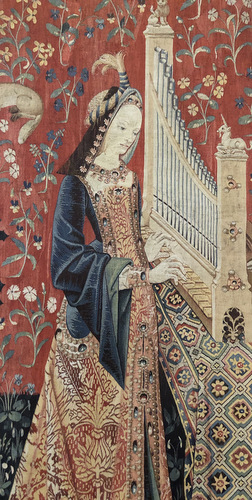
So now I’ll skip ahead to a couple of 20th c. tapestries that evoke these medieval masterpieces with a modern sensibility. We weavers still do not make reasonable wages. Some things never change.
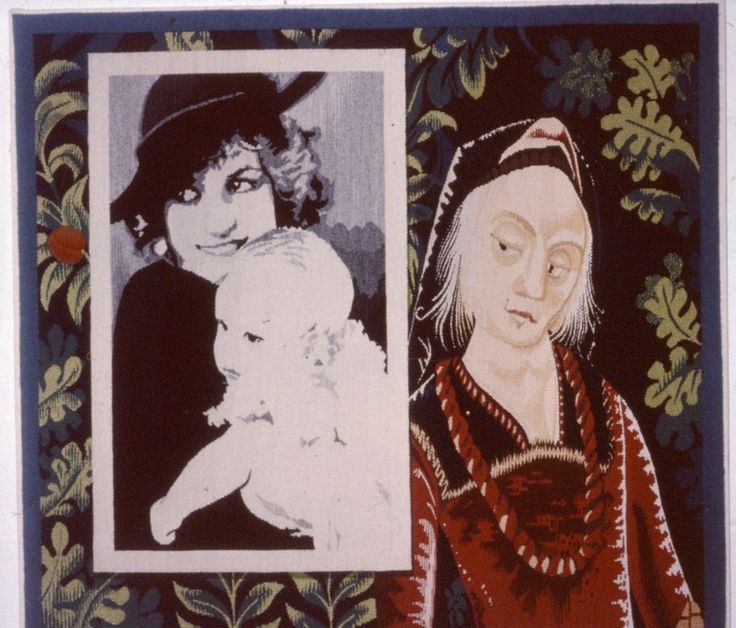
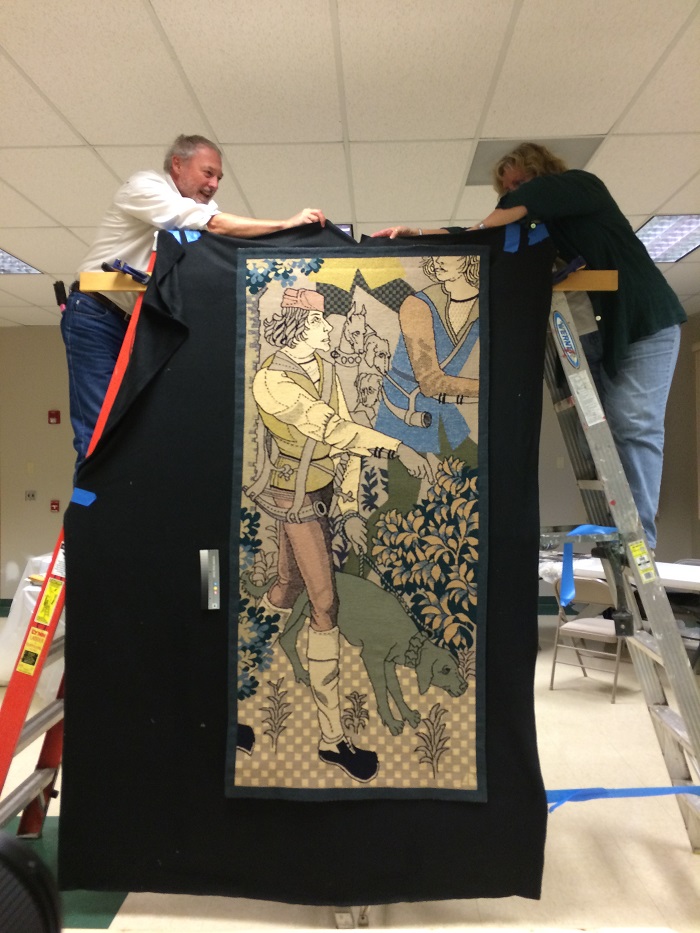
Archie Brennan was my teacher for about a dozen years, and actually he still is. There will always be something to learn from him as long as there are images of his work available and memories of his terrific advice. Like medieval tapestries, the more you look the more there is to see.
While in Paris, Bob and I visited the address, 31 Rue de Seine, near and dear to my heart. It’s been a well known address over the decades of the past century and a half. First, it’s known as the residence of George Sands (1804-1876), who happened to write about the “Lady and the Unicorn,” as well as set her novel Jeanne in the Boussac castle, where the tapestries lived during that time period. Fast forward a few years, and Raymond Duncan (brother to Isadora) lived at this address where he ran a sort of commune for art students. Archie found himself there in the early 1950s, weaving tapestries for Raymond. I have no idea where Archie’s work there may have gone.
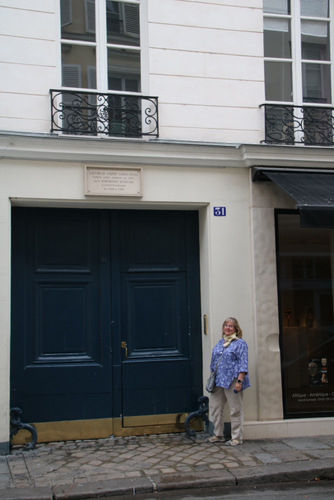
You can’t imagine how it made my day to visit this spot! We went into the art gallery next door (to the right in the photo, Hourde Charles-Wesley) to ask about the current owners of #31. The gallery assistant said the gallery has a key that opens those big blue doors to the courtyard. Archie has written about that courtyard, where Duncan made large sculptures. I’ve often felt that I could picture it based on Archie’s descriptions (and one tiny photo I found online years ago). And voila! I saw it for real.
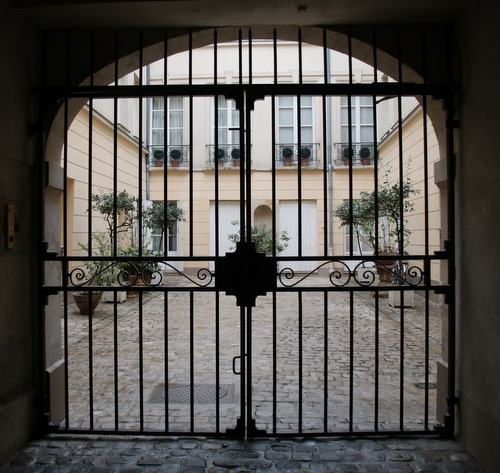
The gallery assistant told us that recently the owners found some artwork in the basement. She didn’t say what–Raymond Duncan’s sculptures? Archie’s tapestries? I doubt it, but something may have been left from that time period, and, if so, likely it would be work of some of the students. Archie felt that Duncan’s work would not stand the test of time. Most of the residents of the commune were students, mostly wealthy American and Japanese women who found it trendy to live in a Bohemian setting and study under Duncan. Archie was one of a few artists who were paid to work there. Interesting times.
This piece happened to be in the courtyard. I have no idea if it’s one of the pieces found in the basement. I have a lot of questions, and luckily I now have a contact in the gallery next door!
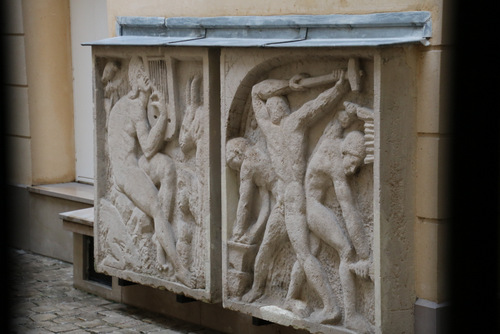
Recounting these days in Paris: the disappointment at not seeing “The Lady and the Unicorn,” the excitement of getting past those big blue doors at 31 Rue de Seine, piecing things together from my (almost) 20 years of working in tapestry, revisiting medieval history; well, it’s been memorable for me. Tapestries, Paris, 500 years apart. It was a moment.

Woah! The organ is so pretty and Archie’s piece from the unicorn is incredible. Oh and that courtyard, wow.